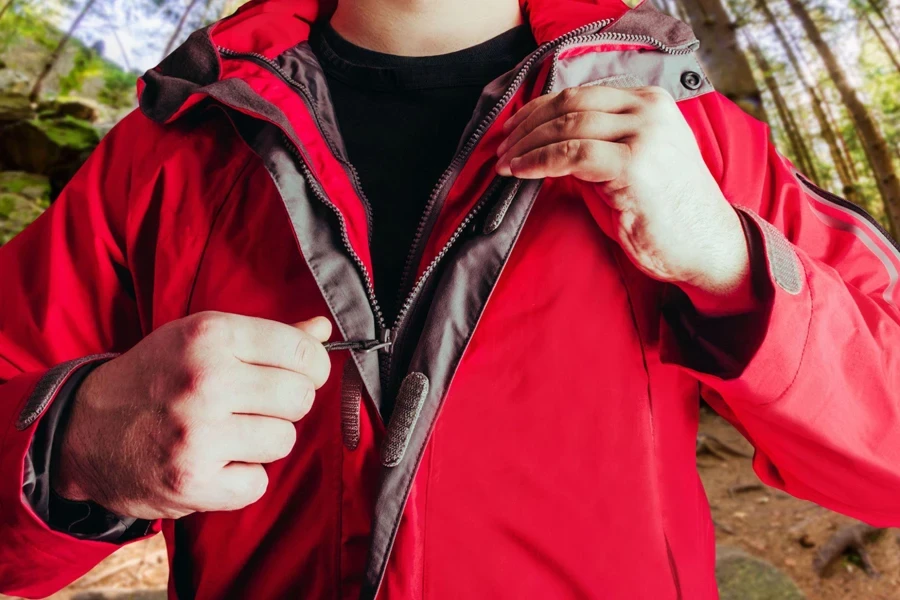Table of Contents
– Introduction
– Hiking Jacket Market Overview
– Essential Considerations for Selecting the Ideal Hiking Jacket
– Top Hiking Jacket Picks for 2024
– Conclusion
Introduction
Choosing the ideal hiking jacket is vital for any outdoor journey, acting as a key piece of gear for comfort and protection. For business buyers acquiring inventory for companies and shops, understanding the significance of this selection is crucial. This guide succinctly presents the essential aspects to consider in your choice and introduces the best hiking jackets for 2024, ensuring your selections stand out in both functionality and style.
Hiking Jacket Market Overview
The global outdoor and hiking jacket market has experienced steady growth in recent years, driven by the rising popularity of outdoor activities and the increasing emphasis on active lifestyles. In 2021, the outdoor clothing market was valued at approximately USD 13.9 billion, with hiking jackets comprising a significant portion of this market. Industry experts project the outdoor jacket market to expand at a compound annual growth rate (CAGR) of around 4.8% to 6.6% between 2022 and 2032. By 2031, the global outdoor clothing market is projected to reach USD 23.6 billion, with hiking jackets continuing to be a key product category.
North America currently dominates the outdoor apparel market, accounting for a substantial 40% market share in 2023. The region’s diverse climate and strong outdoor culture have fueled the demand for hiking jackets suitable for various weather conditions. In 2021, the North American market for outdoor clothing was estimated at USD 4.2 billion, with American consumers spending up to USD 33.2 billion on eco-friendly and comfortable outdoor apparel.

Essential Considerations for Selecting the Ideal Hiking Jacket
Weight and Packability
When every ounce counts on the trail, savvy hikers turn to lightweight, packable jackets that won’t weigh them down. These featherweight marvels can be effortlessly stuffed into the tiniest corners of a backpack, ready to deploy at a moment’s notice when the weather turns. Some jackets even transform into their own stuff sacks or smuggle away into a hidden pocket, making them the ultimate trail companion for minimalist adventurers. Whether people are thru-hiking for weeks on end or embarking on an epic multi-day excursion, a trusty, lightweight layer is worth its weight in gold when they need to shave pounds without sacrificing warmth and protection from the elements.
Durability and Abrasion Resistance
When hikers are bushwhacking through dense underbrush or scrambling over jagged boulders, they need a jacket that can take a beating without shredding to pieces. Enter the indomitable force of ripstop nylon, a rugged fabric engineered to shrug off snags, tears, and abrasions like a superhero deflecting bullets. This tough-as-nails material is often reinforced with a grid pattern of sturdy threads, creating a virtually indestructible barrier against the trail’s most unforgiving elements. For extra fortification in high-wear zones like shoulders and elbows, some jackets feature reinforced patches or double-layered fabric, ensuring the trusty shell remains intact even after years of relentless abuse.
Waterproofing and Breathability
The holy grail of hiking jackets boasts a rugged, impenetrable membrane like Gore-Tex or eVent, which laughs in the face of driving rain and howling wind, keeping the bone dry when the elements are at their worst. But these high-tech fabrics don’t just block out the wet stuff – they also allow sweat vapor to escape through billions of microscopic pores, ensuring people don’t end up soaked from the inside out during strenuous ascents. It’s like having a personal atmospheric assistant, constantly regulating moisture so the hikers stay cool, collected, and focused on crushing miles instead of wallowing in a clammy, miserable cocoon.

Insulation and Warmth
When the mercury plummets on the trail, savvy hikers reach for jackets fortified with high-tech insulation to trap precious body heat. For frosty forays, synthetic fill is a stalwart ally, stubbornly refusing to succumb to dampness and maintaining its warming powers even when soggy. Down fill, on the other hand, boasts an unrivaled warmth-to-weight ratio, packing maximum heat into a featherlight package. But beware – this fluffy wonder wilts in the face of moisture, transforming into a chilly, matted mess when wet. Choose the insulated armor wisely based on the forecast – synthetic for damp, unpredictable conditions and lofty down for dry, frigid climes where every ounce counts.
Ventilation and Temperature Regulation
When hikers are huffing and puffing up a steep trail, the last thing they want is a clammy, sweat-soaked jacket clinging to the skin. That’s where ventilation features come to the rescue, transforming the hiking shell into a personal climate-control system. Pit zips are the unsung heroes of temperature regulation, allowing hikers to unleash a blast of fresh air right where they need it most – under their arms, where sweat tends to pool.
These underarm zippers act like miniature exhaust vents, releasing excess heat and moisture before they have a chance to turn their jacket into a sauna. Mesh-lined pockets also pull their weight, serving as sneaky air conduits that promote airflow and breathability without sacrificing weather protection. When the going gets tough and their internal furnace kicks into overdrive, these ventilation features can mean the difference between a miserable, soggy slog and a comfortable, enjoyable hike.
Fit and Mobility
A well-designed hiking shell should move with hikers, not against them, allowing for unrestricted mobility and a full range of motion. Articulated sleeves are the unsung heroes of jacket design, featuring clever cuts and angles that mimic the natural bend of their elbows. This means they can swing their arms freely without feeling like they’re fighting against their own clothing. Gusseted underarms also play a crucial role, with diamond-shaped fabric panels that eliminate bunching and binding when they reach overhead. But a jacket’s fit isn’t just about what’s on the outside – it’s also about what’s underneath. A truly versatile shell should accommodate a full layering system, with enough room to comfortably wear a base layer and mid-layer without feeling like an overstuffed sausage.

Hood Design and Adjustability
When the wind is whipping and the rain is lashing, a well-designed hood can be the difference between a miserable slog and a comfortable, enjoyable hike. The best hoods are like a fortress for the face, with adjustable drawcords that allow people to cinch the opening down to a snug, weather-tight fit. Stiffened brims are the unsung heroes of hood design, acting like a miniature awning to keep driving rain and sleet from pelting the eyes and obscuring the vision.
Some hoods even feature a wired peak that hikers can bend and shape to their liking, creating a customized shield against the elements. But not every hike demands a hood, and that’s where removable designs come in clutch. With a few quick zippers or snaps, they can ditch the hood and transform their jacket into a sleek, streamlined shell that won’t get in the way when the skies clear.

Pockets and Storage
When hikers are miles from civilization, their jacket becomes the portable base camp, and pockets are their best friends. A well-designed hiking shell is a master of organization, with strategically placed stash spots that keep the essentials within easy reach. Chest pockets are the unsung heroes of the trail, allowing people to grab their map, compass, or snacks without ever breaking stride or fumbling with the backpack.
These clever pouches sit high and proud, easily accessible even when the hip belt is cinched tight. For the most valuable cargo, like keys or a smartphone, an internal pocket provides an extra layer of security, keeping them safe from the elements and any unexpected tumbles. Some jackets even feature specially designed pockets for specific gear, like a dedicated sleeve for a GPS device or a moisture-resistant pouch for the camera.

Top Hiking Jacket Picks for 2024
1. Arc’teryx Beta AR Jacket: This versatile jacket features Gore-Tex Pro fabric for exceptional waterproofing and breathability. With a durable construction and a helmet-compatible hood, it’s ideal for challenging hikes and mountaineering.
2. Patagonia Torrentshell 3L Jacket: Made from recycled materials, this eco-friendly jacket offers reliable protection against the elements. Its 3-layer H2No Performance Standard shell ensures waterproofing and breathability, while the adjustable hood and pit zips provide added comfort.
3. The North Face Dryzzle Futurelight Jacket: Featuring The North Face’s innovative Futurelight technology, this jacket offers unparalleled breathability and waterproofing. Its lightweight design and packability make it perfect for fast-and-light adventures.
4. Outdoor Research Microgravity AscentShell Jacket: This jacket utilizes Outdoor Research’s proprietary AscentShell technology, which combines the benefits of softshell flexibility with hardshell protection. It’s highly breathable, stretchy, and waterproof, making it ideal for active hikers.
5. Columbia OutDry Ex Reign Jacket: With Columbia’s OutDry Extreme technology, this jacket provides exceptional waterproofing by placing the membrane on the outside of the fabric. It’s lightweight, durable, and features underarm venting for enhanced breathability.
Conclusion
Investing in a high-quality hiking jacket is crucial for staying protected and comfortable on the trails. By considering factors like waterproofing, insulation, durability, and fit, you can find the perfect jacket to suit your customers’ needs. Our top picks for 2024 offer a range of options for various hiking styles and conditions, ensuring that hikers can find the ideal companion for their outdoor adventures.
Don’t forget to click the “Subscribe” button to stay updated with more articles that align with your business needs and interests on the Alibaba Reads sports blog.




